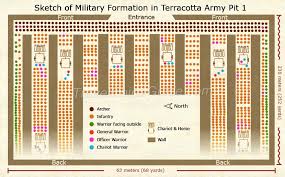
The Terracotta Army: An Eighth Wonder of the World
The Terracotta Army, a sight that has captivated the world, is hailed as the "Eighth Wonder of the World." This vast collection of life-sized terracotta sculptures depicts the armies of Qin Shi Huang, the first emperor of China. Let's delve deeper into the fascinating arrangement of these pits:
The Three Pits of the Terracotta Army
The Terracotta Army is organized into three main pits, arranged in a distinctive "pin" or "品" formation – a common architectural layout in ancient China. Each pit holds a unique segment of the emperor's vast army and provides valuable insights into military organization and artistry of the Qin Dynasty.
Pit 1: The Astonishing Vanguard
Pit 1, the largest of the three, houses the main force of the Terracotta Army. It’s a sight that takes your breath away – row upon row of infantrymen, archers, and charioteers stand in battle formation, ready to march into eternity.
- Scale and Formation: This pit, measuring a staggering 230 meters long, 62 meters wide, and 5 meters deep, contains over 6,000 figures. The soldiers are arranged in strict battle formation, showcasing the military precision of the Qin Dynasty.
- Variety and Detail: Pit 1 is remarkable for the diversity of its figures. Each soldier possesses unique facial features, hairstyles, and expressions, hinting at the individuality of the craftsmen who created them. The figures’ armor, weapons, and clothing are intricately detailed, offering a glimpse into the military attire and craftsmanship of the time.
Pit 2: The Tactical Core
Pit 2 unveils the tactical heart of the Qin army. While smaller than Pit 1, it is rich in military diversity, revealing the complex strategies employed by the Qin.
- Military Divisions: This pit features a mixed force of chariots, cavalry, archers, and infantry arranged in a sophisticated battle array. The arrangement highlights the coordinated use of different military units in Qin warfare.
- Chariots and Cavalry: Pit 2 is renowned for its chariots, each drawn by four terracotta horses. The craftsmanship of these chariots, complete with intricate details and weaponry, is exceptional. The presence of cavalry units further underscores the Qin army's mobility and tactical prowess.
Pit 3: The Command Center
Pit 3, the smallest of the three, is thought to represent the command center of the army.
- High-Ranking Officials: This pit contains figures believed to be high-ranking officers, including a chariot with what appears to be a commander and his driver. The presence of these figures suggests a hierarchical command structure within the Qin army.
- Strategic Significance: The location of Pit 3, situated at the rear and slightly elevated from the other pits, reinforces its interpretation as a command post. From this vantage point, officers could have overseen the army's movements and issued strategic commands.
The Legacy of the Terracotta Army
The Terracotta Army stands as a testament to the ambition, artistry, and military might of the Qin Dynasty. Each pit, with its unique composition and figures, offers a window into the past, allowing us to marvel at the ingenuity and craftsmanship of ancient China.
Q&A
Q: When was the Terracotta Army discovered?
A: The Terracotta Army was discovered in 1974 by farmers digging a well.
Q: How were the terracotta figures made?
A: The figures were created using terracotta clay, fired in kilns, and then painstakingly painted and assembled.
Q: Why was the Terracotta Army created?
A: It’s believed the Terracotta Army was created to protect and serve Emperor Qin Shi Huang in the afterlife, reflecting the ancient Chinese practice of providing for the deceased in the next world.